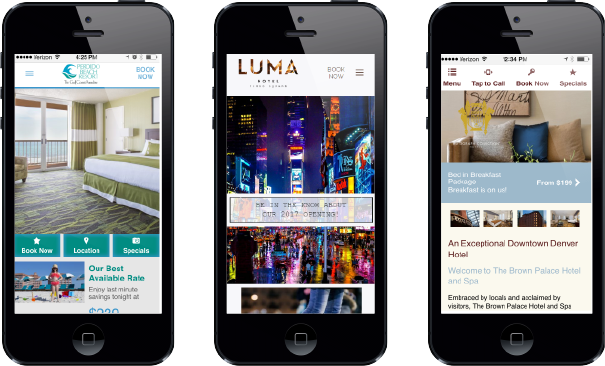
By Max Starkov and Samra Seifu
Background
Introduced in 2016 as Google’s response to other mobile publishing platforms like Apple News and Facebook Instant Articles, Google’s AMP (short for Accelerated Mobile Pages) began to spark interest amongst online retailers across industries.
In hospitality, some website developers have been trying to convince hoteliers that they need to have AMP version of their website.
What is Google AMP? It is an open platform with the sole objective to help publishers create mobile content (articles and commentary, quick opinion postings, etc.) that download fast on mobile and other devices.
AMPs are characterized with stripped down mostly textual content and simple, no-clutter page layouts, and are hosted by Google, which at least in theory ensures fast downloads. Google has restrictions on what type of content can be included on AMPs, utilizes special HTML and coding, and allows only very basic styling (read: Design) of the page.
What should hoteliers do about Google AMPs?
It is immediately clear that AMP pages feature simple, textual/blog-like page layout with stripped-down content. Obviously, the mere objective of the hotel website as the main “digital face” of the hotel and its product and services, and the main direct booking source for the property, goes beyond what an AMP layout can offer.
Today’s hotel planning and booking customer journey is becoming increasingly complex in this multi-device, multi-channel and multi-touch point environment we operate in. On average, the travel consumer goes through 19 different touchpoints before making booking (Google Research). Each one of these touchpoints presents an opportunity for the hotel to build a brand connection, influence intent, and be there for every step of the way. Nine out of ten people are “cross-device” Internet browsers and researchers, using multiple devices sequentially (mobile, desktop, laptop, tablet, wearable devices, etc.) and moving from one device to another at different times.
This is the reason why travel consumers and hoteliers alike prefer fully responsive hotel websites that feature the same in-depth content (visual, textual, promotional) on every device. Having an AMP version of the hotel website for mobile users goes against today’s best practices and is like going “back in circles” and moving away from fully responsive website to the old days of adaptive websites with separate versions for desktop, tablet and mobile.
Here are only a few questions hoteliers must consider before contemplating AMPs:
- Did you invest time and money on a unique website design that best reflects your property, its locations, services and amenities? Your custom design won’t go with you if you move to AMP. These design elements are critical to the hotel website, and they cannot be compromised without missing out on online revenue.
- Does your website feature rich media in the form of videos, slide shows, photo galleries, storyboard page layout with content and image blocks, etc.? These are typical features of today’s hotel website that help present well your product, services and amenities and “sell the dream” of experiences awaiting at your hotel. AMP might be able to load the text content quickly, but the rich media content will lag behind.
- Does your current website feature deep, relevant and visually appealing content? A typical hotel website for a 4-5 star property should have a minimum of 35-40 pages of unique and highly visual content (including content blocks, high res visuals, videos, floor plans, etc.), describing and illustrating the hotel product, services and amenities, positioning your hotel as the perfect choice from the perspective of your main market segments (corporate transient, groups, leisure, family, social event planners, etc.), as well as establishing the hotel as the “hero” of the destination. This content serves dual purpose: provide information and visualize to potential guests everything they need to know about the hotel, as well as provide tremendous SEO value. This high impact content value, the prerequisite for customer engagements and conversions on the website, will be lost in the AMP stripped-down version of the website.
- Does your website feature any third-party integrations? Because AMPs forces websites to feature as few capabilities as possible to ensure fast mobile downloads, this new format favors only stripped down page layouts and functionality. Removing third-party capabilities and elements such as reservation widgets and other technology integrations like Reservation Abandonment Applications, live rates or customer review feeds, promotional banners, slides and lightboxes, social media integration, RFP forms/sign-ups, etc. will affect negatively user engagements, website conversions and revenue.
- Does your website feature “live” rates and promotional banners with real-time availability and pricing for tonight’s rate or specials for the upcoming weekend? Since AMP content is cached, such live rate feeds will be lost.
One of the most promoted features of AMPs is that it promises fast download speeds on mobile devices. We believe that fast download speeds are no longer an issue with today’s CMS technology and in this day and age of 4G LTE and cloud hosting. Any fully responsive hotel website, supported by up-to-date cloud hosting and CDN (Content Delivery Network) and advanced CMS technology should have no issues with download speeds. As an example, here at HeBS Digital we do not launch a hotel website with lower download speed of 95/100 in the Google Page Speed test, even without being an AMP site. In other words, you do not need an AMP site for your property website to download fast.
Conclusion:
AMPs are not designed to maximize hotel’s direct online revenue. A stripped down, Google hosted version of the hotel website (i.e. AMPs) goes against the mere objective of what the hotel website is all about. Hotel websites are not news sites or blogs, but complete ecommerce websites featuring rich visual content that have the singular objective of presenting the hotel product in the best possible light, engage the online traveler and generate maximum direct bookings.


